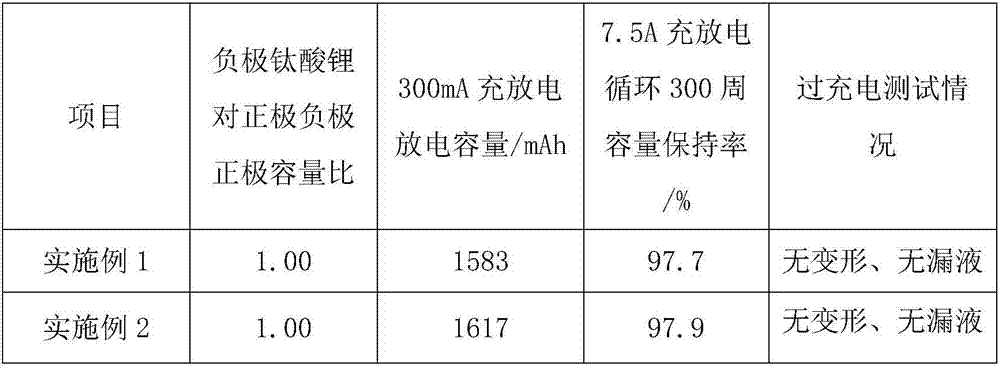Lithium titanate-based lithium ion battery negative electrode, lithium ion battery and formation method of lithium ion battery
An ion battery, lithium titanate technology, applied in battery electrodes, secondary battery charging/discharging, secondary batteries, etc., can solve problems such as only 90%, lithium precipitation safety accidents, low battery design capacity, etc., to improve design The effect of capacity
- Summary
- Abstract
- Description
- Claims
- Application Information
AI Technical Summary
Problems solved by technology
Method used
Image
Examples
Embodiment 1
[0033] Example 1 (the addition amount of the additive in this example is about 0.2wt% of the lithium titanate active material)
[0034] Lithium-ion battery negative electrode production:
[0035] Add 13.5g PVDF to 550mL NMP, fully stir to dissolve; add 4.5g conductive carbon black and stir for 30 minutes; add 449.1g lithium titanate material (capacity 165mAh / g), 0.9g commercially available silicon oxide powder (half-cell measured first charge Capacity 2380mAh / g, first cycle efficiency 33.7%), stirring for 60 minutes. The obtained slurry was coated on an aluminum foil with a thickness of 20 micrometers, oven-dried at 120 degrees, and the coating weight gain was 220 g / m2 (both sides).
[0036] Compacted according to density 2.0, cut into a width of 57mm.
[0037] Lithium-ion battery production:
[0038] Add 12g PVDF to 350mL NMP, fully stir to dissolve; add 12g conductive carbon black and stir for 30 minutes; add 800g commercially available NMC622 ternary positive electrode m...
Embodiment 2
[0046] Embodiment 2 (the addition amount of the additive described in this embodiment is about 1wt% of the lithium titanate active material)
[0047] Production of lithium titanate-based lithium-ion battery negative electrode:
[0048] Add 13.5g PVDF to 550mL NMP, fully stir to dissolve; add 4.5g conductive carbon black and stir for 30 minutes; add 445.5g lithium titanate material (capacity 165mAh / g), 4.5g commercially available tin dioxide (half-cell measured first charge capacity 1350mAh, first week efficiency 31%) powder, stirred for 60 minutes. The obtained slurry was coated on an aluminum foil with a thickness of 20 microns, and dried in an oven at 120 degrees, and the coating weight gain was 220 g / m2 (both sides).
[0049] Compacted according to density 2.0, cut to a width of 57mm
[0050] Production of 18650 lithium-ion battery:
[0051] Step is with embodiment 1.
Embodiment 3
[0052] Example 3 (the addition amount of the additive in this example is about 2wt% of the lithium titanate active material)
[0053] Add 13.5g PVDF to 550mL NMP, fully stir to dissolve; add 4.5g conductive carbon black and stir for 30 minutes; add 441g lithium titanate material (capacity 165mAh / g), 9g commercially available nickel oxide powder (actually measured first charge capacity 980mAh / g , first week efficiency 38.1%), stirred for 60 minutes. The obtained slurry was coated on an aluminum foil with a thickness of 20 microns, and dried in an oven at 120 degrees, and the coating weight gain was 220 g / m2 (both sides).
[0054] Compacted according to density 2.0, cut into a width of 57mm.
[0055] Production of 18650 lithium-ion battery:
[0056] Step is with embodiment 1.
PUM
| Property | Measurement | Unit |
|---|---|---|
| Thickness | aaaaa | aaaaa |
| Porosity | aaaaa | aaaaa |
Abstract
Description
Claims
Application Information
 Login to View More
Login to View More - R&D
- Intellectual Property
- Life Sciences
- Materials
- Tech Scout
- Unparalleled Data Quality
- Higher Quality Content
- 60% Fewer Hallucinations
Browse by: Latest US Patents, China's latest patents, Technical Efficacy Thesaurus, Application Domain, Technology Topic, Popular Technical Reports.
© 2025 PatSnap. All rights reserved.Legal|Privacy policy|Modern Slavery Act Transparency Statement|Sitemap|About US| Contact US: help@patsnap.com


